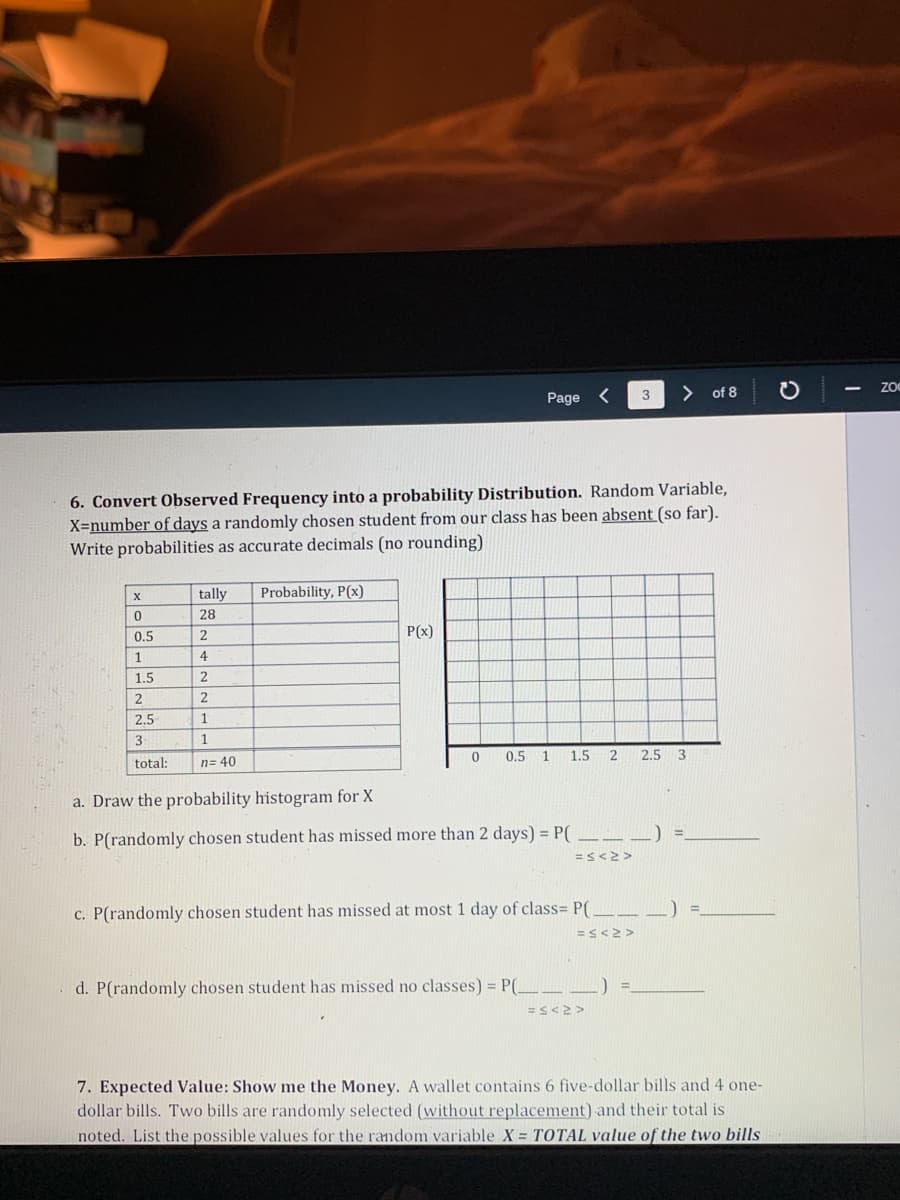6. Convert Observed Frequency into a probability Distribution. Random Variable, X-number of days a randomly chosen student from our class has been absent (so far). Write probabilities as accurate decimals (no rounding)
6. Convert Observed Frequency into a probability Distribution. Random Variable, X-number of days a randomly chosen student from our class has been absent (so far). Write probabilities as accurate decimals (no rounding)
MATLAB: An Introduction with Applications
6th Edition
ISBN:9781119256830
Author:Amos Gilat
Publisher:Amos Gilat
Chapter1: Starting With Matlab
Section: Chapter Questions
Problem 1P
Related questions
Concept explainers
Contingency Table
A contingency table can be defined as the visual representation of the relationship between two or more categorical variables that can be evaluated and registered. It is a categorical version of the scatterplot, which is used to investigate the linear relationship between two variables. A contingency table is indeed a type of frequency distribution table that displays two variables at the same time.
Binomial Distribution
Binomial is an algebraic expression of the sum or the difference of two terms. Before knowing about binomial distribution, we must know about the binomial theorem.
Topic Video
Question

Transcribed Image Text:ZO
Page <
3
of 8
6. Convert Observed Frequency into a probability Distribution. Random Variable,
X=number of days a randomly chosen student from our class has been absent (so far).
Write probabilities as accurate decimals (no rounding)
tally
Probability, P(x)
28
0.5
2
P(x)
1
4
1.5
2.5
1
1
0.5
1
1.5 2
2.5 3
total:
n= 40
a. Draw the probability histogram for X
b. P(randomly chosen student has missed more than 2 days) = P(
c. P(randomly chosen student has missed at most 1 day of class= P( _) =
=S<2>
d. P(randomly chosen student has missed no classes) = P(_
7. Expected Value: Show me the Money. A wallet contains 6 five-dollar bills and 4 one-
dollar bills. Two bills are randomly selected (without replacement) and their total is
noted. List the possible values for the random variable X = TOTAL value of the two bills
Expert Solution
This question has been solved!
Explore an expertly crafted, step-by-step solution for a thorough understanding of key concepts.
This is a popular solution!
Trending now
This is a popular solution!
Step by step
Solved in 3 steps with 2 images

Knowledge Booster
Learn more about
Need a deep-dive on the concept behind this application? Look no further. Learn more about this topic, statistics and related others by exploring similar questions and additional content below.Recommended textbooks for you

MATLAB: An Introduction with Applications
Statistics
ISBN:
9781119256830
Author:
Amos Gilat
Publisher:
John Wiley & Sons Inc

Probability and Statistics for Engineering and th…
Statistics
ISBN:
9781305251809
Author:
Jay L. Devore
Publisher:
Cengage Learning

Statistics for The Behavioral Sciences (MindTap C…
Statistics
ISBN:
9781305504912
Author:
Frederick J Gravetter, Larry B. Wallnau
Publisher:
Cengage Learning

MATLAB: An Introduction with Applications
Statistics
ISBN:
9781119256830
Author:
Amos Gilat
Publisher:
John Wiley & Sons Inc

Probability and Statistics for Engineering and th…
Statistics
ISBN:
9781305251809
Author:
Jay L. Devore
Publisher:
Cengage Learning

Statistics for The Behavioral Sciences (MindTap C…
Statistics
ISBN:
9781305504912
Author:
Frederick J Gravetter, Larry B. Wallnau
Publisher:
Cengage Learning

Elementary Statistics: Picturing the World (7th E…
Statistics
ISBN:
9780134683416
Author:
Ron Larson, Betsy Farber
Publisher:
PEARSON

The Basic Practice of Statistics
Statistics
ISBN:
9781319042578
Author:
David S. Moore, William I. Notz, Michael A. Fligner
Publisher:
W. H. Freeman

Introduction to the Practice of Statistics
Statistics
ISBN:
9781319013387
Author:
David S. Moore, George P. McCabe, Bruce A. Craig
Publisher:
W. H. Freeman